(The riverboat captain is a storyteller, and Captain Don Sanders will be sharing the stories of his long association with the river — from discovery to a way of love and life. The is the seventh of a long and continuing story.)
By Capt. Don Sanders
Special to NKyTribune
Winters are wicked on the Ohio River. So as autumn grew colder, the MARJESS paddled upstream to Andy Fisher’s Southern Ohio Marine, an exclusive, private marina with the equipment and facilities to remove our boar from the water and store it ashore for the impending season of ice and snow. “Cap’n Andy,”’ as we liked to call Mr. Fisher when he wasn’t within earshot, was a man of about the same size and build as my dad, though a few years older. Both seemed to always have the stub of an unlit cigar clenched between their teeth on one side of their jaws. They were of a serious, no-nonsense breed. Had my father an older brother, Andy Fischer could have been he.
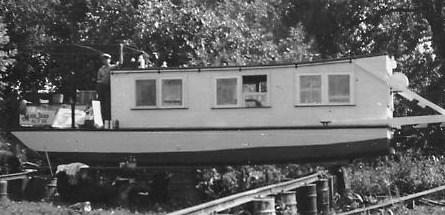
Young Don aboard the MARJESS ‘on the hard’ at Andy Fisher’s Southern Ohio Marine)
Our paddlewheeler sat “on the hard” at Andy Fisher’s throughout the following spring and into the beginning of summer while Dad was working extra hours at night and sleeping during the day, as policemen often had to do to make ends meet. Mr. Fisher was withholding summer storage charges on the MARJESS as long as the boat was prepared for launching within a reasonable time. So Mom and I packed buckets, rags, paint, and brushes to the boat and started getting it spruced-up.
As money for lunches was scarce, each day my modest collection of silver dollars was volunteered for bread, lunch meat, cheese, and a soft drink apiece. A dollar bought a lot in those days, and by the time the last ounce of silver was rung-up in the register at Charlie’s delicatessen, the MARJESS was ready for the water.
Andy Fisher’s mechanism for getting boats in and out of the river was a homemade cable car contraption that ran on railroad tracks embedded into a steep concrete ramp going from the boat storage yard and down to the Ohio River. Once the MARJESS was positioned onto a cradle attached ahead of the trolley, “Cap’n Andy” carefully guided our boat down the incline and into the river, deep-enough, until it floated free.
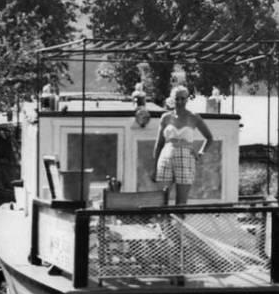
Don’s mother, Margaret, on the boat at the Marina.
We wintered two seasons at Andy Fisher’s, but after our last launching, the MARJESS paddled smartly past the Covington Boat Harbor to a new marina half a mile downstream below the C&O Railroad Bridge where our friend Walter Hoffmeier was starting a new harbor he named for himself: “Walt’s Boat Club.”
It would be the beginning of a new era of river adventures.
“Walt’s” wasn’t yet much of a boat harbor; just several newly-constructed floats and a tall, gangly, floating dock on the stern-most end of the fleet, where, because Walter was charging my folks the “family price,” we were relegated to tie. But the fledgling marina was alive with activity. Walt being the persuasive supplicator he was, convinced truck-driving patrons of the Bridge Cafe, which he managed, to divert portions of their cargoes to the boat harbor site.
Soon truckloads of rubble from the “Bottoms” of old Cincinnati being torn down for a highway called the Third Street Distributor were dumped over the riverbank to enlarge the tiny parking area. Rafter beams of clear yellow poplar cut from first-growth forests before 1848, all over 20-feet in length, were hauled to the site and shoved “down the hill” where they would become the frames for new floating docks. Loads of unseasoned, random-width red oak planks came from another source and were destined to become the decking atop the poplar frameworks. Empty steel oil drums to buoy the docks afloat the water were bought for a quarter apiece — delivery included. Rolls of steel cable, recently removed from elevator shafts in tall buildings of downtown Cincinnati, arrived courtesy of an elevator company connection to tie the growing line of floats together, end to end, as a rigid unit.

Any Fisher’s way of getting boats in and out of the river.
Amongst all the hubbub of activity, Walt assigned my brothers and me to our first task. Provided with a carpenter’s hammer, a block of wood, and a small steel pry-bar each, we were shown how he wanted the ten-penny nails removed from a jumbled mountain of lumber dumped helter-skelter about the property. A set of sawhorses supported the heavy boards, laid nail-side up. Each spike was hammered on the pointy-end until they were driven through the board that was then flipped over so the flat nail heads protruded upward. Close to each nail was placed the block of wood. With the metal bar resting atop the block and the nail head grasped firmly within the “V-notch” of the tool, a steady pull on the pry-bar dislodged the nail that was placed on the ground exactly where Walt had specified.
By the time they were all removed, a steel cone of nails, some two-feet high and weighing over 100 pounds was created. The boards once cleaned of nails, were neatly stacked for subsequent use.
As load after a load of rubble was dumped over the embankment above the harbor, I noticed all sorts of scrap metal mixed-in with the fill and began extracting what I could scrounge and piled it aside. By the end of the day a handsome heap of scrap, higher than my head, was waiting for a truck to lug it off to the scrapyard. The next weekend when I returned to the harbor, my mountain of junk was gone.
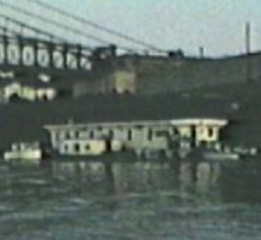
CBH Headboat. MARJESS paddled smartly past the Covington Boat Harbor.
“Where’s my scrap?” I demanded.
“Wasn’t yours… was mine,” Walt answered.
“Then give me half the money for collecting it.”
“Didn’t get any money – traded it, ” he informed.
Walt had the mountain of metal hauled to Missell’s junkyard, and instead of selling the metal for money, he traded evenly, pound-for-pound, for bolts and nuts, angle iron, and other steel odds and ends that became the fittings and fasteners for the new floats under construction. Most of the nails previously removed from the planks found their way into boxes and cans until they were eventually straightened and reused to fasten the oak dunnage decking atop the poplar docks.
Walter, I quickly realized, was the supreme “recycler” before the word was invented. When I began Can-Do All-American All-Aluminum Recycling Company on Covington’s Old Towne Plaza in 1980, a portrait of Walter Hoffmeier was displayed in the show window of the shop with the caption, “He Taught Us How.”

Walt’s boat harbor was just several newly-constructed floats.
Meanwhile down by the water’s edge, the new floating docks were taking shape by the skilled hands of craftsmen-friends of Walt’s who were “volunteers,” as was everyone else working at the harbor. Later on, when I was helping Walt full-time after school each day, I asked him, “How much you gonna pay me?” “ Pay you?” he snorted, “Yer gettin’ yer supper, ain’t ya?” Immediately the subject was dropped, for I would rather be working at the boat harbor for my supper than hanging around the house, back home.
The clear yellow poplar beams taken from the attics of ancient buildings in the oldest neighborhood in downtown Cincinnati, “the bottoms”, and hauled to Walt’s measured nearly 20-feet in length, 24 inches wide, and a full four-inches thick. Four full-length beams running lengthwise formed the main longitudinal supports of the floats, while others were sacrificed and cut into shorter lengths to create the lateral members.
Those planks my brothers and I had worked on, earlier to remove the nails, became the frames for four steel oil drums in each end of the dock structures. The drums were not affixed permanently to the framework, but were confined inside the frames by their buoyancy, alone, in such a way that should an oil drum fill with water, it would detach itself and fall away to the river bottom without dragging down the float with the added weight of the sinking drum.
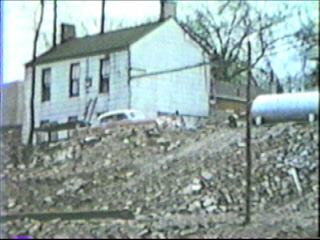
Rubble from the ‘Bottoms’ of old Cincinnati was dumped over the riverbank below the old house.
Once the framework of an individual float was launched and buoyant, random-width oak boards were hand-carried from where they were stacked “on the hill,” down to the water’s edge, loaded aboard the KIRK – the most artfully-constructed jon-boat I have ever seen, even to this day — and were rowed over to where each plank was placed crossways on the skeletal dock so that one edge of the oaken deck was even with one longitudinal poplar beam with just an inch, or so, of overhang. But the opposite side of the float was overhung by whatever the random lengths of each individual planks were.
Next, came the ten-penny nails we had pulled earlier from the pile of planks. These nails were rusty and bent; on any other construction project they would have been discarded and new nails purchased. However, the reclaimed nails only needed a little pounding as they lay on their sides on the hard oak and they were almost good as new. When straightened, they worked well once a technique for driving them through the green wood was established.
Soon, driving the awkward, rusty nails through the rock-hard oak became my specialty, but I did it matter-of-factly as just another chore needed doing that earned me my supper, eaten at that time in the cellar of an ancient house on top of the hill where an old lady, the grandmother of a Covington policemen lived. The house was without a toilet or running water, and, as I quickly learned, one had to be especially careful standing outside the house, for, without warning, she would raise a window and empty her slop jar into the yard regardless of anyone standing below.
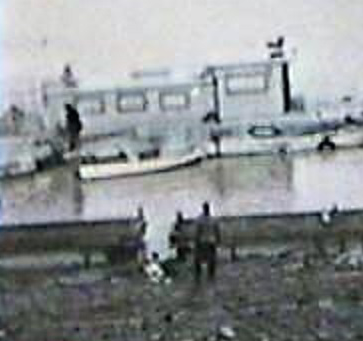
Floats under construction; new docks taking shape.
Directly across from the ramshackle cottage facing on West Second Street, later renamed Highway Avenue, lived a man about Walter’s age who was highly regarded as an outstanding “cabinetmaker,” a rank above a general carpenter. One afternoon as I was pounding the old nails straight and driving them home through the oaken boards, the old gentleman stood over and scrutinized me as I worked. Knowing his reputation with woodworking, I did my best to drive each nail true through the hard, resisting planks. Without saying a word, he observed a while and then shuffled off to find Walter before returning home.
Later, Walt shared the conversation he and the old craftsman had concerning my work. Old Craftsman: “I can’t believe that boy over there is straightening those old rusty nails and driving them through that hard oak.” Walt: “Well, I told him… He better be!”
Eventually a home-like, roomy headboat replaced the ramshackle cottage that was soon demolished to make room for more parking. In time, over 600 feet of the oak and poplar floats stretched downriver from the headboat, but it would take a couple of years, perhaps longer, for that to happen. And in the course of those years, I was busting myself to remain welcome at Walter and his little wife Lorraine’s supper table. She was some fine cook, but the benefits her husband offered were why I was really there – mainly, everything boiled down to the freedom I had spending as much time as possible on the river.
Many years later, I summarized what those early days with Walt meant: “Walter Hoffmeier had a decisive influence on a kid who’d never been much good at anything in particular until he met that skinny, hard-cussing, taskmaster who taught him carpentry, painting, and river skills. Most of all, he taught a boy what was expected of a man if he wanted to hold onto on a job though the wages paid were a evening’s supper and the opportunity to be on the river working in every sort of weather, on all stages of the river from a lake-like pool to raging floods and crushing ice.”
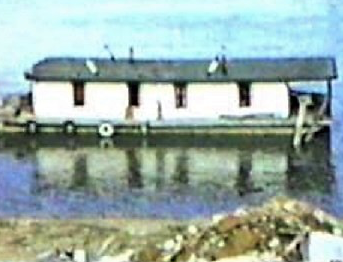
Eventually a home-like headboat replaced the ramshackle cottage.
As I grew older each passing year, my rather-strict parents allowed me to spend more time at the boat harbor helping Walter. School got out at 3:15 in the afternoon and four-o’clock found me getting off the bus at the top of the hill.
A number of chores were waiting as I stepped aboard the headboat where there was never a lack of work to do. Cold river winters found us as busy as we were on balmy, summer days. Ice was a special hazard to the marina and to Walter’s and our houseboats, which were kept afloat there instead of taking them out for the winter.
Before Markland Dam was built, the old-style dams could be “thrown” so that the movable sections, called “wickets,” rested on the river bottom making the river a wide-open, free-flowing stream without fabricated obstructions holding back water or, worse, ice. Ice flowing down the river became a monstrous, grinding bulldozer plowing everything in its path. During one such bitter winter when ice threatened the harbor, Walter allowed the entire marina, including the headboat and our houseboats, to be beached out onto the shore as the level of the water fell with the wickets down at Lock and Dam # 37, below us, where we were safe until the grating, frozen river passed by. Once the ice was gone and the wickets were back in place, the water rose and refloated everything again. To this day I remain awed with Walter’s ingenious system of saving the boats, floats, and headboat. Something he learned, he later revealed, from the shantyboating days of his youth.

Beached out — ice was a hazard to the marina
As in all episodes of life, those idyllic days seemed like they would last forever. But on one hot spring day, just before graduating from high school, I was working high on the riverbank attaching a steel cable to a “deadman”, an anchorage the harbor would be needing when the newly-constructed high-lift lock and dam below us would raise the Ohio River some 14 feet, when the telephone bell mounted on the outside of the headboat loudly rang.
A few minutes later, Walt called over, “Get your ass in here and get cleaned-up. Your old man’s coming to get you!” “Where’s he taking me,” I asked? “He’s taking you to college…” My heart dropped into my stomach.
Though I headed, later that day, to an open house for graduating high school seniors at Eastern Kentucky State Teachers College, one of my life’s most exciting summers still lay before me when I started “decking” on the AVALON, a steam-powered excursion boat that traveled from one end of the Mississippi River System to the other.
So, when I began steamboating at age 17, I already had seven years of river experience and training that quickly caught the attention of Captain Ernest E. Wagner, the AVALON’s Master, who continued the education that Walter had begun.
At summer’s end, after returning from my first season on the steamboat, I enrolled at Eastern. By December, as 1959 closed without me around the harbor to do the heavy work, Walter suffered a stroke shoveling a truckload of ashes onto the walkway and soon died.
My father felt he could no longer keep the MARJESS without my help, and it was sold and trailered to Williamstown Lake, south of the Ohio River, where it soon sank and later burned.

MARJESS was sold and trailered to Williamstown Lake where it soon sank.
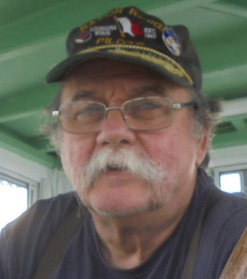
Captain Don Sanders is a river man. He has been a riverboat captain with the Delta Queen Steamboat Company and with Rising Star Casino. He learned to fly an airplane before he learned to drive a “machine” and became a captain in the USAF. He is an adventurer, a historian and a storyteller. Now, he is a columnist for the NKyTribune and will share his stories of growing up in Covington and his stories of the river. Hang on for the ride — the river never looked so good.
* * * *
See The River #6 by Captain Don Sanders.

























I love your stories! Please keep them coming!
JoAnne